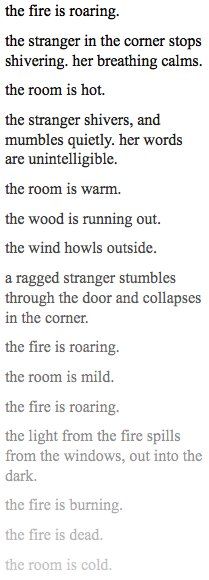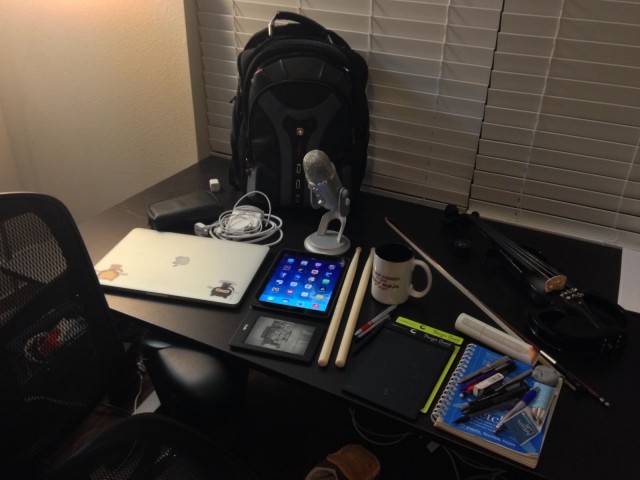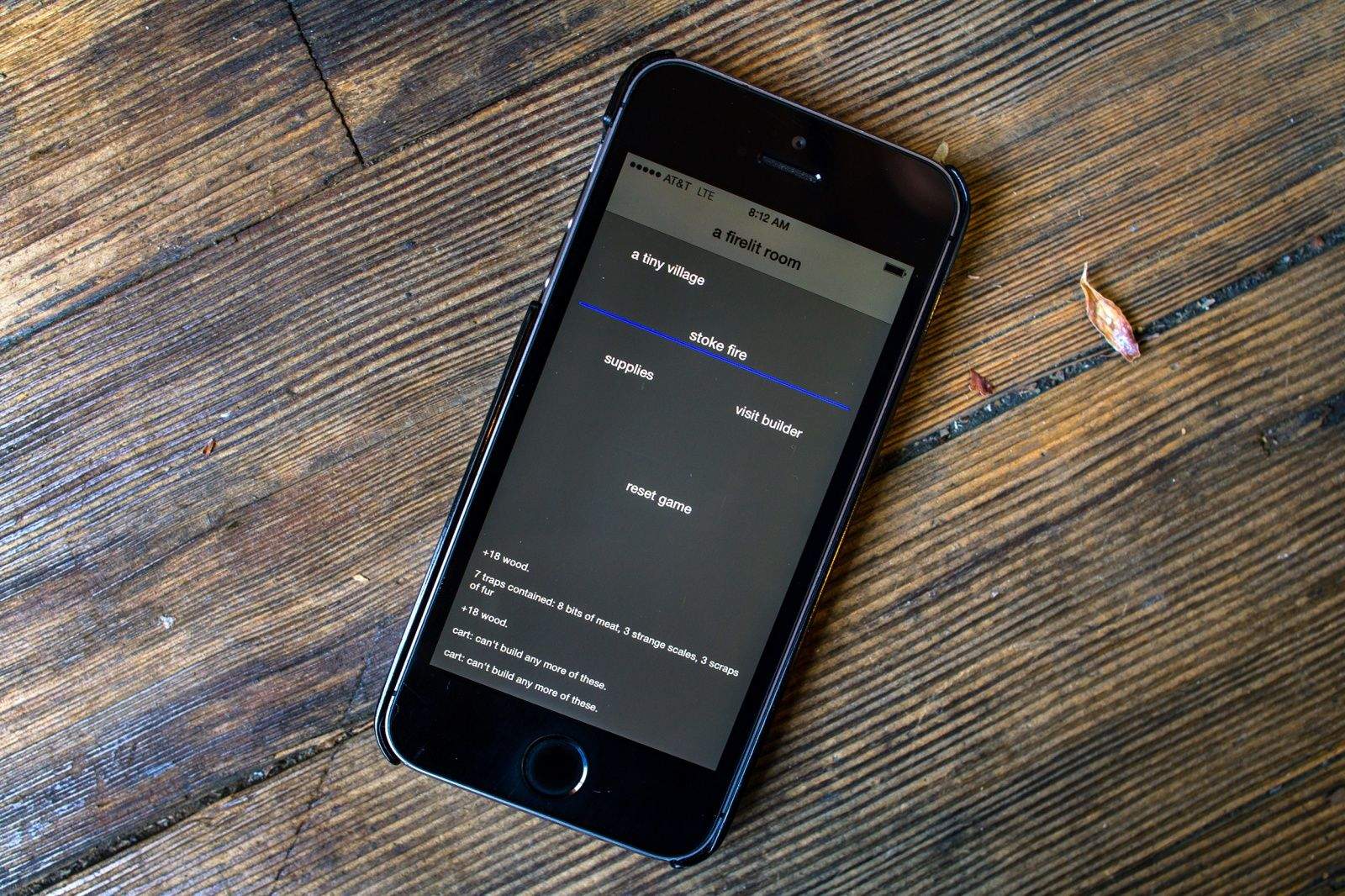Two coders who’ve never met sat in their respective man caves 1,400 miles apart making a game that proves once and for all that whiz-bang graphics aren’t necessary when it comes to building a hit.
Called A Dark Room, their “minimalist text adventure” has stormed the App Store — averaging 10,000 downloads a day (at $0.99 a pop) and currently holding the No. 1 position for paid iPhone games (see our review here).
Here’s how Michael Townsend and Amir Rajan created an indie iOS game with no graphics that became the most unlikely success of the year.

“I wrote my first game in QBasic on the family 386, and I’ve been hooked ever since,” creator Michael Townsend says. “I suppose you could say that I am an enthusiastic amateur.”
For Townsend, the genesis of A Dark Room came when he played Candy Box, a role-playing 2013 browser game featuring ASCII art, created by a 19-year-old student in France. “I was totally in love with [its] apparent simplicity and unexpected depth,” Townsend says. Inspired, his initial idea was to make A Dark Room “an idle game with a narrative.”
Townsend spent just one day thinking about possible directions for the project, and then jumped straight into coding it — hacking the game together with javascript with a view to playing it in the web browser. “When I’m excited about an idea, I never have the discipline to sit down and hammer out a design first,” he says.
Like a lot of creative projects that come together quickly, the speed gave the whole endeavor a stream-of-consciousness feel. “I put together the UI for the opening screen before I had much of an idea about anything. Its sparse appearance drove toward an equally sparse apocalyptic setting.”
Once Townsend put together an initial version, he posted it on social media and sat back to watch the analytics. One of the places the game made a decent-sized splash was on Hacker News.
A software engineer named Amir Rajan read about it there. Rajan had been working in the software industry for the past eight years but was currently taking a sabbatical to reevaluate his career. While he sat at home in Dallas, Texas, he was busy planning a way to strike out on his own. His living costs were low and he had sold most of his belongings to support himself. Now all he needed was an idea.
“Two months in, I came across the web version of A Dark Room,” Rajan says. He loved what he saw. He emailed Townsend immediately to ask if he could port the game over to iOS, perhaps adding a bit of his own creative spin. Intrigued, Townsend gave him the stamp of approval. “For the next five months, developing the iOS version of A Dark Room was my drug,” Rajan says.

It proved a total shot in the dark. “I wish it was as easy as just taking the web version and translating it to a language that iPhone understands,” he says. If he had simply seen it as a way to make a quick buck, it might have been more straightforward. But he didn’t.
“It’s very difficult to translate a piece of poetry from one language to another,” Rajan says. “I’d like to say that porting A Dark Room to iOS was a similar task.”
One of the main problems for Rajan was that idle web games typically don’t translate well to mobile. On a desktop, an idle game is perfect since it can be left for long periods of time without the need for activity. By contrast, a mobile game is all about instant gratification — particularly when there’s a payment involved. “I had to make sure that the game progressed quickly, but not so fast that it left the player confused,” Rajan continues. “It was a constant balancing act, I spent way too much time mulling over the pacing of A Dark Room.”
The iOS version of the game took around five months to develop. “I was learning the iOS platform as I was developing the game, which made the development process quite a bit slower,” Rajan says. “When I initially took on the project, the game was simply a means for me to learn iOS development.”
After it landed in the App Store, Rajan began promoting it relentlessly online, using Twitter and Reddit. That process took another five months before he reaped the results we see today. Even so, he’s slightly befuddled about the exact moment when the game lit up the sales charts. “Honestly, I have no idea if any of what I did significantly helped the growth of the game, or if it simply went viral on its own,” he says.
Although A Dark Room is not for everyone, it has a strange addictive quality when you get into it: its straightforward (even sometimes ugly) interface doing nothing to dull the slow-boil narrative for what is an clearly an imaginative and surprisingly riveting gameplay. In its own way it’s as more-ish as Flappy Bird. Only very, very different.

[A Dark Room] doesn’t try to sell itself to you with a ‘pitch’ or flashy graphics.
“A Dark Room is different from seemingly everything else in the App Store,” Rajan says, without much exaggeration. “It’s a complete oddball frankly, and goes against the grain of ‘successful’ iOS games. It’s a premium title. It doesn’t employ sleazy techniques to force you into paying for In App Purchases. [There are] zero in-game ads. It doesn’t try to sell itself to you with a ‘pitch’ or flashy graphics. It treats you like an adult, and doesn’t shove a load of instructions down your throat. It pretty much does the opposite of most other games in the App Store. And because of this, A Dark Room stands alone and shines.”

Oh yes, and despite the game’s success, Rajan and Townsend have still never been in the same room — Rajan is based in Dallas, Texas and Townsend lives in Ottawa, Canada.
“I’ve honestly never really thought about it,” Townsend says when I ask him about it. “Working with remote teams is pretty standard in the software world these days, so I guess I’m just used to it.”
Rajan echoes the sentiment. “It actually came pretty naturally,” he says. “I’m a bit of an introvert … so interacting over email and chat for most of our communication just felt natural and in line with my personality.”
However they choose to work, it seems to be, well, working. Here in 2014 you don’t need a massive marketing budget or to be in the same office in order to create a smash hit game.
You just need coding skills and a unique idea — and then some serious time spent in a dark room.
Buy from: App Store


